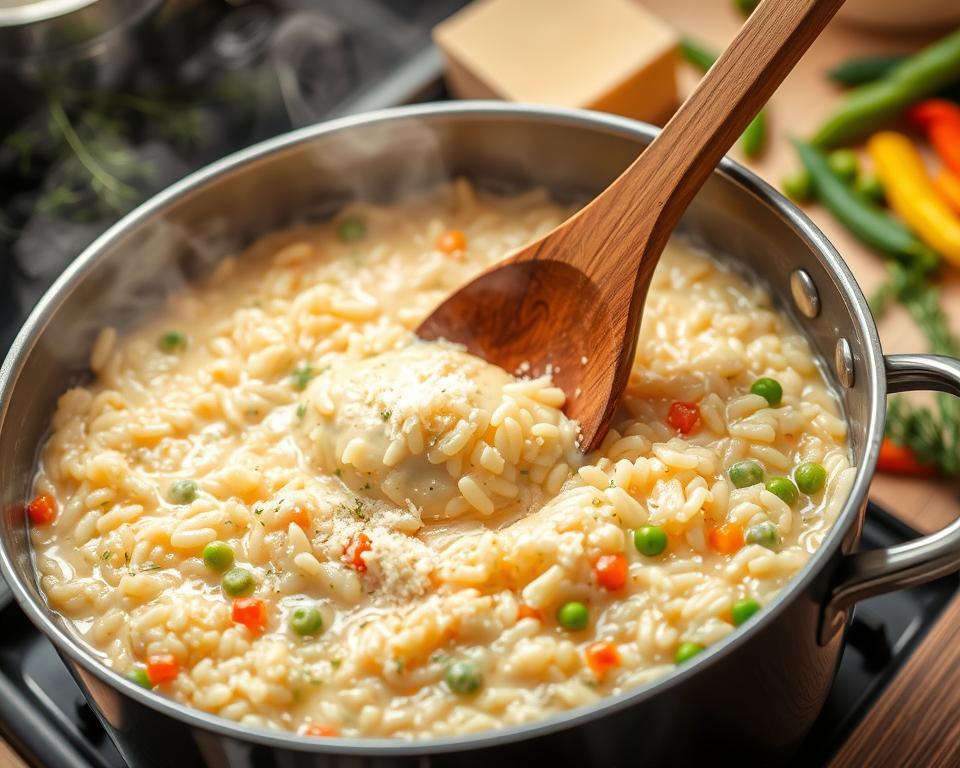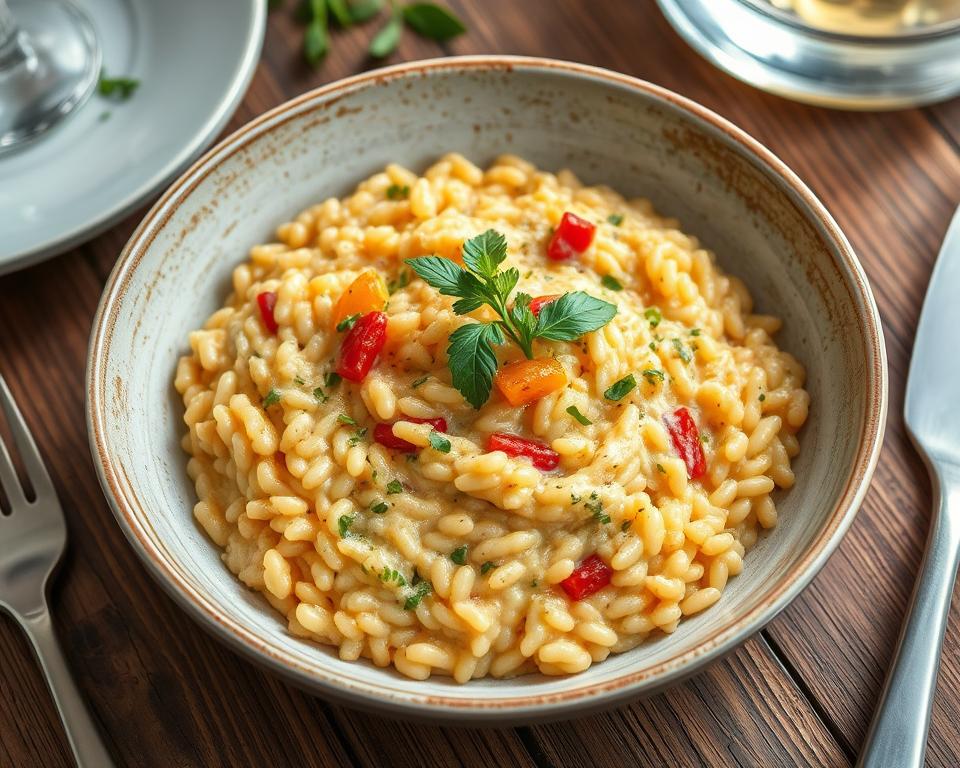Risotto is a creamy, comforting rice dish loved in Italian cuisine. It ranges from the famous Risotto alla Milanese to the earthy Mushroom Risotto. This guide will teach you how to make perfect risotto, covering history, techniques, and recipes.
Read interesting things at : warlockgroup
Key Takeaways
- Risotto is a creamy and comforting rice dish that originated in Northern Italy.
- Arborio rice is the star ingredient, known for its ability to release starch and create a velvety texture.
- Mastering the slow-cooking technique is essential for achieving the perfect al dente texture and releasing the rice’s natural starch.
- Risotto can be customized with a variety of ingredients, from classic Parmesan and saffron to seasonal vegetables and seafood.
- Patience and attention to detail are the hallmarks of a well-executed risotto dish.
Introduction to Risotto
Risotto is a beloved Italian rice dish loved by many. It’s a creamy, comforting dish from Northern Italy. It’s made with special Arborio rice, giving it a unique taste and texture.
Making risotto is all about patience and care. You slowly add hot broth to the rice while stirring. This makes the dish rich and flavorful. It can be a main dish or a side, and it pairs well with many ingredients.
Starting your risotto adventure means learning to mix rice, broth, and seasonings just right. Each bite takes you to Italy’s kitchens, where risotto has been perfected for years. Get ready to fall in love with this Italian cuisine and the creamy rice dish that’s loved worldwide.
“Risotto is the culinary equivalent of a luxurious cashmere sweater – comforting, elegant, and a true expression of Italian artistry.”
The History of Risotto
Risotto, the famous Italian rice dish, comes from northern Italy. Rice has been a key ingredient in local food for centuries. This made it a perfect choice for creating this iconic dish.
Origins in Northern Italy
The first records of risotto date back to the 14th century. It was mentioned in a Milanese cookbook. Over time, different areas and families in northern Italy made their own versions. Each had its own special flavors and ways of making it.
Evolution into a Beloved Dish
Risotto became more popular and became a beloved part of Italian food. Now, it’s loved all over the world as a sign of Italy’s rich food traditions. Its ability to use many ingredients and flavors has made it a favorite in Italian cuisine.
“Risotto is a labor of love, a dish that demands patience and attention to detail, but the rewards are truly worth the effort.”
The story of risotto shows the lasting food traditions of northern Italy. Here, new ideas and keeping old ways alive have made a beloved Italian cuisine staple.
Risotto Ingredients
The secret to a great risotto is in the ingredients. At its core is arborio rice. Its short, plump grains make the dish creamy.
A flavorful broth and a bit of white wine are next. The broth, whether vegetable stock or chicken, adds depth. The wine brings a touch of acidity, balancing the rice’s creaminess.
Arborio Rice: The Star Ingredient
Arborio rice is crucial for a creamy risotto. Its high starch content makes it release starches as it cooks. This results in a velvety texture.
Flavorful Broth and Wine
The broth is essential for the risotto’s flavor. You can use vegetable stock or chicken stock. As the rice cooks, it absorbs the liquid, becoming creamy.
A splash of white wine is also added. It adds a subtle acidity and helps deglaze the pan. This releases flavorful bits from the bottom.
“Risotto is a labor of love, but the end result is well worth the effort. The perfect balance of creaminess, flavor, and texture is a true culinary delight.”
Essential Risotto Cooking Techniques
Learning to make risotto is like playing a musical piece. Each step is important for the dish’s creamy texture and taste. From toasting Arborio rice to cooking it slowly, every action matters.
Toasting the rice is the first step. It seals the rice’s starches, readying it to soak up the broth. Stirring constantly during toasting makes the rice golden and sets the stage for creaminess.
While cooking, stir the rice gently but constantly. This helps release the starch, making the risotto velvety. The patience and care needed here turn simple ingredients into a masterpiece.
| Technique | Purpose |
|---|---|
| Toasting the rice | Seals in the natural starches, preparing the rice to absorb the broth |
| Constant stirring | Encourages the release of starch, creating a rich, creamy texture |
| Gradual addition of broth | Allows the rice to slowly absorb the flavors, resulting in a well-balanced dish |
The last step is adding the broth slowly. This lets the rice soak up each bit of broth, making the dish balanced and flavorful.
These cooking techniques are key to making great Italian cuisine. By learning to make risotto, anyone can improve their cooking skills and make delicious dishes.
Classic Risotto Recipes
Risotto lovers can dive into timeless recipes. From the bright risotto alla milanese to the rich mushroom risotto, these dishes highlight Italian cuisine’s depth and variety.
Risotto alla Milanese
Risotto alla milanese comes from Italy’s north. It’s made with Arborio rice, saffron, and Parmesan cheese. This mix creates a creamy, savory dish that’s both rich and balanced.
Mushroom Risotto
Mushroom risotto is perfect for a cozy meal. It combines Arborio rice with various mushrooms. This blend offers a deep, earthy taste that celebrates Italian simplicity.
| Risotto alla Milanese | Mushroom Risotto |
|---|---|
| Saffron-infused rice, Parmesan cheese | Variety of mushrooms, Arborio rice |
| Vibrant yellow color | Earthy, umami-packed flavors |
| Creamy, rich texture | Comforting, satisfying dish |
“Risotto is a labor of love, but the rewards are truly magnificent. Each classic recipe is a testament to the enduring culinary traditions of Italy.”
Risotto Variations
Risotto is a versatile dish from Italian cuisine. It can be made in many ways, like seafood risotto and vegetarian risotto.
Seafood Risotto
Seafood risotto brings a touch of the sea to the dish. It combines shrimp, scallops, and mussels with creamy arborio rice. This mix creates a rich and indulgent taste experience.
Vegetarian Risotto Options
Vegetarian risottos are great for those who prefer plant-based meals. They use seasonal vegetables, mushrooms, and herbs. Options like butternut squash or wild mushroom risotto are endless. These dishes offer a meatless way to enjoy the creamy goodness of risotto.
| Risotto Variation | Key Ingredients | Flavor Profile |
|---|---|---|
| Seafood Risotto | Shrimp, scallops, mussels | Briny, creamy, indulgent |
| Vegetarian Risotto | Seasonal vegetables, mushrooms, herbs | Earthy, savory, comforting |
“Risotto is a labor of love, but the end result is worth every moment of stirring and patience.”
Serving and Pairing Risotto
Making the perfect risotto is an art. But the real magic happens when you serve it with the right flavors. To make this creamy dish special, pay close attention to how you serve and pair it.
The way you present risotto matters a lot. It’s best served hot and creamy right after cooking. Serve it in shallow bowls or plates to show off its texture and smell.
Pairing risotto with the right wine pairings can make your meal even better. Light- to medium-bodied white wines like Pinot Grigio, Chardonnay, or Sauvignon Blanc work well. They balance the richness of the risotto with a refreshing touch.
For a heartier Italian cuisine experience, try a light- to medium-bodied red wine. Barbera or Chianti can complement the creaminess of risotto. Their acidity and tannins create a perfect balance.
The secret to serving and pairing risotto is to think about its flavors and textures. Choose your serving style and wine pairing wisely. This way, you’ll make the risotto experience unforgettable.
Troubleshooting Common Risotto Issues
Making the perfect risotto can be tricky, even for experienced cooks. You might face issues like a dry or watery texture. Don’t worry, we’ve got tips to help you fix these problems and become a pro at Italian cuisine.
Achieving the Ideal Consistency
Getting the right texture in risotto can be a challenge. If it’s too dry, add more warm broth slowly and stir hard until it’s creamy. If it’s too wet, heat it up and stir constantly until it dries out a bit.
Mastering the Cooking Time
- Use the right rice, like Arborio, for risotto.
- Watch the cooking time closely. It’s all about patience and attention for the perfect texture.
- Don’t overcook it, or it will become mushy.
Incorporating Flavors
If your risotto tastes bland, add more broth, wine, or aromatics like onions and herbs. Try different mixes to find the flavor you like best.
“The secret to a good risotto is in the stirring. It takes time and effort, but the result is worth it.”
By tackling these common risotto problems, you’ll get better at making this Italian cuisine dish. With practice and patience, you’ll make risotto that’s creamy, tasty, and just right every time.
Risotto: A Labor of Love
Making a perfect risotto is a labor of love. It needs patience, dedication, and a love for slow cooking. This Italian dish is known for its creamy texture and rich flavors. Every step, from picking the right rice to stirring the pan, is crucial.
The art of making risotto is a dance of time and temperature. The chef must watch the broth and the rice’s starches closely. This careful attention ensures the rice is just right, with a perfect balance of creaminess and bite.
The effort put into making risotto is worth it. The finished dish shows the chef’s skill and dedication. It’s a mix of textures and tastes that truly captures Italian cuisine’s essence. Whether it’s the creamy Milanese-style or the earthy mushroom risotto, each bite is a reward for the patient cooking.
“Risotto is a labor of love, but the rewards are immeasurable. Every stirred, every seasoning, every moment of attention poured into the dish is a testament to the passion and skill of the chef.”
For those who take on the challenge of making risotto, it’s a meditative dance. It’s a journey that satisfies the palate and nourishes the soul. It celebrates patience, attention to detail, and the craft of Italian cooking.

Mastering the Art of Stirring
Preparing the perfect risotto is all about the stirring. This step is key to getting that creamy texture. It takes skill and patience, but it’s worth it.
Achieving Creamy Perfection
The secret to a creamy risotto is in the stirring. Stirring gently and constantly releases the starch from the arborio rice. This makes the risotto smooth and velvety, just like in Italian cuisine.
- Start with a ladle of hot broth and gently stir the risotto until the liquid is absorbed.
- Add another ladle of broth and continue the process, stirring continuously to release the starch.
- Repeat this step-by-step stirring technique until the risotto reaches the desired creamy texture.
Keep a steady, patient pace while stirring. This lets the rice release its starch and become a rich, creamy dish. With practice, you’ll make risotto as good as the best Italian chefs.
Risotto Wine Pairings
Risotto, a beloved Italian dish, deserves a wine that enhances its rich flavors. Its versatility means many wines can pair well, making for a great dining experience.
Choosing the right wine pairing for risotto is key. You want a wine that complements the dish’s bold flavors without overpowering them. The right wine can highlight the Italian cuisine and create a perfect taste balance.
For risotto alla Milanese, a crisp white wine like Pinot Grigio or Sauvignon Blanc is ideal. These wines cut through the creaminess with their refreshing acidity.
“A good wine can make a good risotto even better, while a poor wine can ruin the entire dish.”
For richer risotto dishes, like those with mushrooms or seafood, a light-to-medium-bodied red wine works well. A Chianti or Barbera d’Asti can enhance the earthy or briny flavors, creating a perfect blend.
Exploring Italian wines and trying different pairings is the secret to great risotto wine pairings. With an open mind and a love for flavors, you’ll find the perfect wine to elevate your risotto.
Elevating Risotto with Garnishes
The key to a great risotto is in the ingredients and cooking skill. But, the right garnishes can make it even better. This section looks at how different toppings can improve your risotto in both taste and look.
Adding fresh herbs is a simple yet effective way to garnish risotto. Basil, thyme, or parsley can add flavor and color. For a fancy touch, try microgreens or edible flowers on top.
Want to add some crunch? Try fried shallots, toasted pine nuts, or roasted garlic chips. These add a nice contrast to the creamy risotto.
For a bigger garnish, use sautéed or roasted veggies like asparagus, tomatoes, or zucchini. They make the dish look better and add more flavor and nutrients.
Remember, garnishing risotto is all about trying new things and making it your own. Mix fresh herbs, crunchy bits, and tasty toppings to make your risotto a masterpiece of Italian cuisine.

“The secret to a truly exceptional risotto lies not only in the technique but also in the thoughtful selection of garnishes that bring the dish to life.”
The Versatility of Risotto
Risotto is a dish loved by many around the world. This creamy Italian staple goes beyond its traditional forms. It offers endless chances for new flavors and creative twists.
Risotto is like a blank canvas for chefs and home cooks. It lets them try many ingredients and techniques. From the classic risotto alla Milanese to seafood versions, its versatility is amazing.
Endless Flavor Possibilities
Risotto’s charm lies in its ability to mix many flavors well. You can enjoy a rich mushroom risotto or a zesty lemon and asparagus one. The choices are endless.
- Risotto can be made indulgent with saffron, Parmesan, and truffle oil.
- It can also become a fresh vegetarian dish with seasonal veggies and herbs.
- Seafood lovers can add shrimp, scallops, or crab meat for a creamy treat.
Risotto’s appeal goes beyond flavors. It’s also great for different diets, making it a welcoming part of Italian cuisine.
“Risotto is the ultimate canvas for culinary creativity, allowing you to paint a masterpiece of flavors on your plate.”
Looking for comfort or a culinary thrill? Risotto is perfect. It will delight your taste buds and make you want more.
Risotto: A Celebration of Patience
Making the perfect risotto shows true patience and detail. This Italian dish needs slow cooking. It turns arborio rice into a creamy, flavorful dish. This dedication makes it a rewarding dish to make.
The risotto cooking is a labor of love. The chef must stir the rice and add broth slowly. This slow method makes the rice creamy and perfect.
“Risotto is not a dish to be rushed; it’s a celebration of patience and the transformative power of time.”
The secret to great risotto is the chef’s patience. Each broth addition and stir is a dance. It’s a harmonious mix that creates a dish beyond its parts.
Those who learn to make risotto well get big rewards. The dish’s silky texture and deep flavors show patience’s power. It’s a dish that makes us slow down and enjoy the journey.
Conclusion
In this guide, we’ve explored the history and key ingredients of risotto. We’ve also covered the essential techniques to make the perfect dish. By mastering these, you can improve your Italian cuisine skills and bring Northern Italy’s flavors to your kitchen.
Whether you’re an experienced cook or new to risotto, this guide has given you the tools you need. You can now make exceptional risotto dishes that will impress your family and friends.
We’ve looked at how risotto originated in Northern Italy and became a beloved dish. Understanding the ingredients, like Arborio rice, and cooking techniques is key. Now, you can confidently make risotto masterpieces in your kitchen.
This guide has given you the tools and inspiration to improve your culinary guide skills. You can now impress your loved ones with your risotto expertise. Remember, the true essence of risotto is in the patience, attention to detail, and joy of creating a dish that celebrates Italian cuisine.
